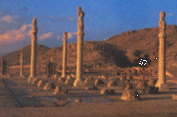
  |


Race and nationality as well as the related traditions, customs and culture have no relevance to the religion, faith or beliefs of a nation, and cannot be interlinked. Even if at one time Iranians have been forced to accept the yoke of Islam, they could not have lost their national identity, traditions, culture and civilization. A people’s culture and traditions are inalterably peculiar to them.
The history and culture of Iranians and that of Semitic peoples were formed in a parallel manner; however, they later grew in separate directions. It was then that Aryan history and culture began to immerge. Almost all Europeans (Germans, Slavs, Scandinavians, Anglo-Saxons, Romans and Greeks), Northern Indians, Iranians and Armenians belong to Aryan history and civilization. All of them are from the same descent, originating from Pamir and the Middle East. In the second millennium B.C. E., they emigrated to south and west. Because of their origin and place of birth, they are technically called Indo-Europeans.
From all those groups, the Hittites and the Medes formed the first Aryan country. Iran’s written history started with the Medes. Hegel, the founder of Historical Philosophy, named Iran the world’s first history making country. The Medes established their country in 708 B.C. Cyrus the Great, conquered the Medes in 550 B.C., consolidating the local Medes kingdom into the Achaemenid Empire. Preceding Cyrus, the Medes ruled as local Anzan (Ilamit) kingdom and paid tribute to the rulers of the Assyrian Empire.
Even though later Muslim Arabs ruled over Iran for almost two centuries, it cannot be said that Iranians became Arabs. Only under duress did Iranians convert to Islam but did not change their culture, which obviously could not have done.
From the view point of history, every nation has a starting point in time. Based on this framework, Mohammad’s flight from Mecca to Medina became the beginning of Arab calendar, at the start of which a desert wondering scattered people became a consolidated nation acquiring governance.
According to the Old Testament, the Semitic people are the descendants of Noah’s oldest son “Shem”, wherefore they are called “Semitic”. Some historians believe that the Semitic people came into being in the fourth millennium B.C.E. in East Africa and then moved to north. Others believe that they came into being in the Arabian Peninsula, a theory that seems more plausible.
Where Mohammad’s Hegira from Mecca to Medina was chosen as the beginning of the Arab calendar, Iranians owe their unity to the Achaemenid dynasty, especially to Cyrus the Great. The Iranian calendar therefore deserves to be based on the beginning of the Achaemenid dynasty. The date of Cyrus the Great’s famous proclamation, which is recognized as the first Bill of Human Rights, is the best possible date for this purpose; for it is a reminder of the greatest historical glory bestowed upon the Iranian people.
History is unalterable; at no time for any reason can it be sacrificed to the changing politics of the day; otherwise, history cannot exist.
It is necessary to reiterate that on the occasion of the same Bill of Human Rights, in the Jewish and Christian’ Holy Book “The Bible”, Cyrus the Great is heralded as a Messiah of God and diffuser of freedom on Earth. Therefore, among billions of the world’s Christians and Jews who consider the Book as Holy Testament, Cyrus has found an exceptional status. Perhaps tens or hundreds of thousand names “Cyrus” they have given to the individuals, has a significant meaning.
Cyrus’ internationally acclaimed proclamation (found on a cylinder in Babylon and is now housed in the British Museum in London) is one of the most incomparable documents that humankind has ever seen.
This decree, along with a philosophic poem by our great Iranian poet “Saadi”, became the motto of the United Nations. It is the pride of the world and of Iranians in particular.
In consideration of all encompassing international importance of the Declaration, the date of Cyrus the Great’s declaration should be the beginning date of the Iranian calendar. In other words, such internationally recognized declaration should be every Iranian’s pride to recognize the year 538 B.C., as the start of Iranian calendar 2544; (2006 + 538 = 2544).
It is suggested that the said date be put in use starting this Now-rooz of 2545, instead of using none-Iranian base for the calendar. Every Iranian must insist on using 2545 anywhere.
The proposed date has no religious or political (Monarchy) roots, but has its unique historic and internationally acknowledged base.
Note:
This article has been written in consultation with several history books, such as Chronological History of Iran by Dr. Pasargad, The History of Iran by Habibollah Shamloui, together with exchange of ideas with knowledgeable friends and in consultation with Dr. Shojaeddin Shafa whose enthusiastic input completed this research.
Dr. Shafa’s handwritten and oral advice: “The date fixed during the reign of Mohammad Reza Shah Pahlavi was based on the history of Declaration of Cyrus the Great at the time; but due to some logically understandable political reasons, it did not meet the final approval. Today those political obstacles have vanished and the date of the Declaration of Human Rights by Cyrus the Great becomes the best choice.
HC
English Ver. متن انگليسی
French Vers. متن فرانسه
متن پارسی Persian version
History of Iran starts 2500 years before Christ .
1160 years later Muslims occupied land of nobles, for over 1400 Iranians fought to deport the occupiers.
33 years ago they re-occupied our homeland. The Renaissance is on its way..!
Persian Kings
|
Cyrus 559-530 BC -29 years
|
بر اين باور هستيم تا زمانی که در ايران زندگی هست، مسئوليت ما است تا در مقابل نا برابری ها مقاومت کنيم
| N | O | , | T | O | , | R | E | L | I | G | I | O | N |